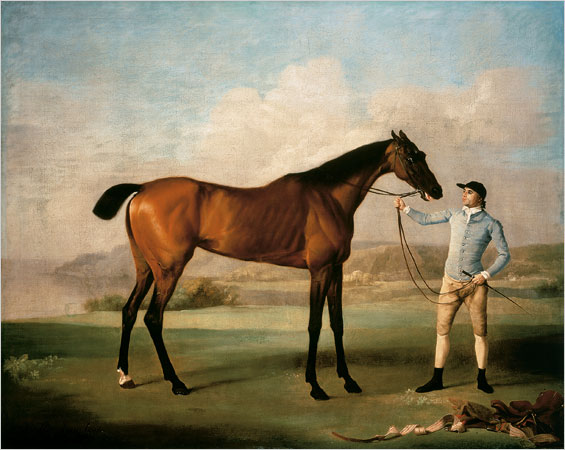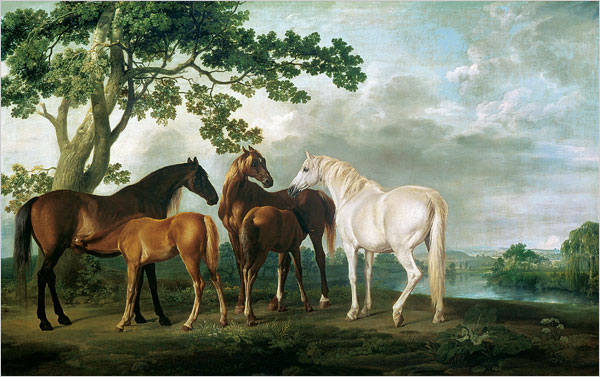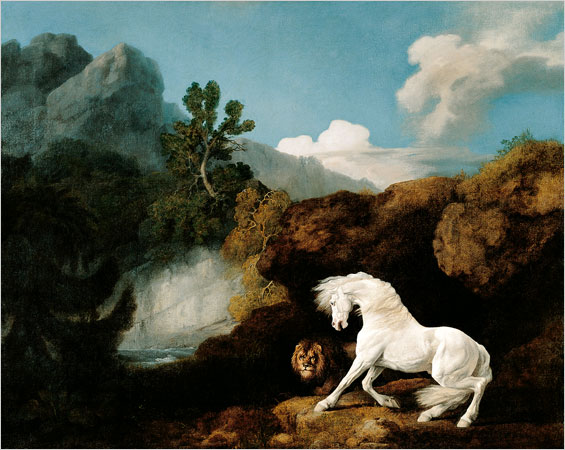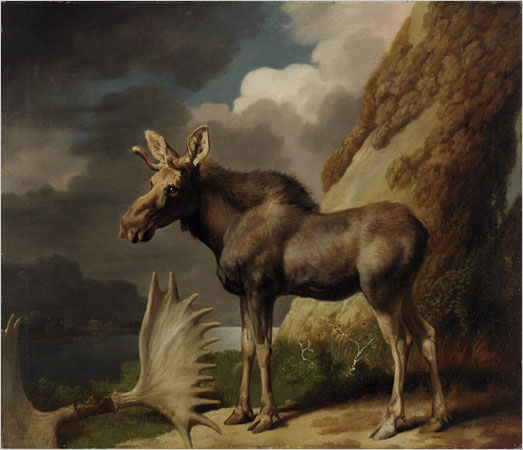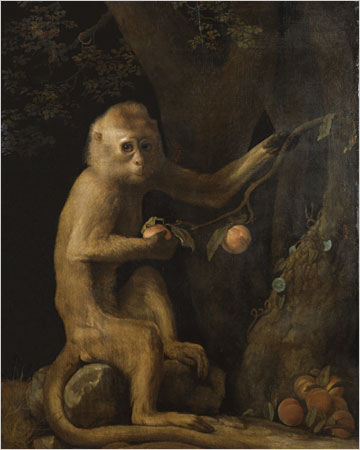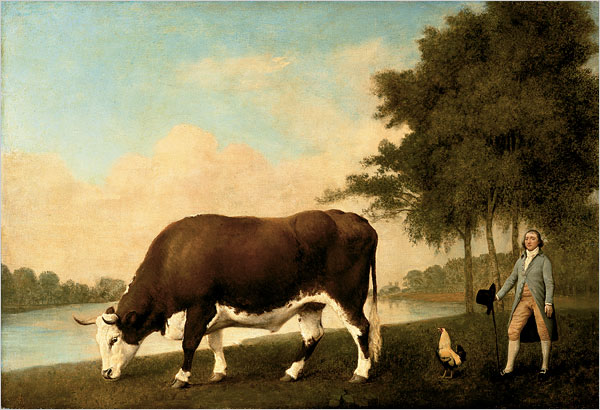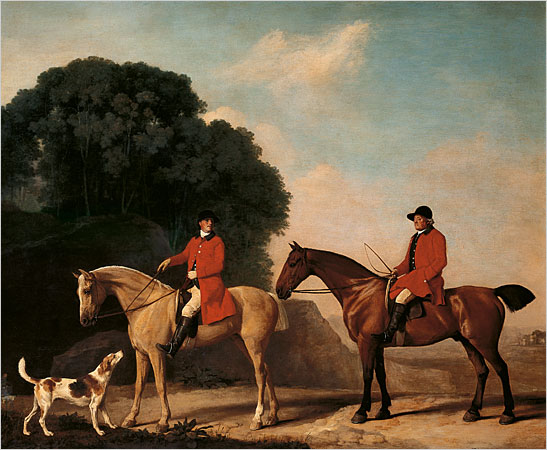George Stubbs, A Horse Frightened by a Lion, 1770. Image courtesy Walker Art Gallery, National Museums, Liverpool, and Frick Collection, N.Y. One of the hardest things to understand in 18th-century European art is how Neoclassical and Romantic tendencies can exist in the same artist, whether David or Goya, William Blake or Stubbs. At the same time that Stubbs was painting his peaceful mares and nursing foals—”equine utopias,” as the scholar Malcolm Warner has called them—he was dreaming up a contrasting image of violence: a stallion attacked by a lion. In 1754, Stubbs had made the obligatory young artist’s journey to Rome. Convinced that he could learn more from direct scientific observation of animals than from the marble copies by idealizing artists, he cut his visit short, but probably not before seeing a Hellenistic sculpture of a lion sinking his teeth into a horse’s back. Stubbs insisted, however, that during a stopover in Morocco on his return journey, he had actually seen a lion attacking a splendid white “barb” (or Barbary horse). During the next 20 years, Stubbs returned again and again to the gory encounter, sometimes accentuating its terrifying or “sublime” aspects, and sometimes giving it a more restrained Neoclassical decorum. Blake, who moved in the same circles as Stubbs and knew his paintings of wild cats, wrote, “The tygers of wrath are wiser than the horses of instruction.” In Stubbs’ fantasy, though, the horses, representing civilization and scientific “instruction,” won the battle over their feral predators. George Stubbs, The Duke of Richmond’s First Bull Moose, 1770. Image courtesy Hunterian Museum and Art Gallery, University of Glasgow and Frick Collection, N.Y. |
The worlds of gentlemanly fashion and natural science often merged in 18th-century England. Alongside their well-stocked stables, Stubbs’ wealthy patrons exhibited exotic wild animals in their private menageries, such as this Canadian bull moose, which Stubbs painted for naturalist William Hunter. Hunter, who argued that many species had become extinct (a radical notion at the time), used the painting in lectures as proof that the moose had nothing in common with the extinct Irish elk, its supposed cousin. Stubbs, who also painted a kangaroo and a nilgai, was admired in scientific circles for the accuracy of his renderings of animals. But Stubbs, never sacrificing the portrait painter’s primary aim, always captured a psychological aspect as well. His bull moose is a mournful portrait, the great and noble animal in exile shorn of his antlers and apparently shorn, too, of some of his coat. A bare mountain face in the background (Stubbs’ fantasy of Quebec) accentuates the mood of lonely desolation George Stubbs, A Monkey, 1799. Image courtesy Walker Art Gallery, National Museums, Liverpool, and Frick Collection, N.Y. |
Beginning in 1775, Stubbs worked closely with the great Neoclassical potter Josiah Wedgwood in a series of chemical experiments to transfer his images via enamel to Wedgwood earthenware plaques. The aim—as scientific zeal combined with decorative intensity—was a permanent surface reminiscent of marble but with flickering visual effects. The Frick has a striking example of a resplendent lounging lioness, her fur sparkling with real gold. This beguiling monkey, painted in a similar Jungle Book vein and hung at the opening of the Frick installation, is meant to give the viewer paws—I mean pause. If the viewer accepts the offered peach, he has been fooled (or “peached”) by the startlingly realistic monkey. Stubbs painted portraits of Wedgwood and his close friend, the poet-naturalist Erasmus Darwin, who was developing ideas concerning the shared heritage of humans and animals, monkeys and men. “The whole is one family of one parent,” Darwin wrote of the diversity of species. Erasmus Darwin and Josiah Wedgwood were Charles Darwin’s grandfathers. George Stubbs, The Lincolnshire Ox, 1790. Image courtesy Walker Art Gallery, National Museums, Liverpool, and Frick Collection, N.Y. |
Stubbs’ peculiar sense of humor, often based on resemblances between humans and animals, gets full play in this knockout portrait of three cocks strutting their stuff in a London park. The painting, which commemorates a great occasion for John Gibbons, the bumpkin on the right, shows Stubbs moving in a narrative direction. Gibbons had won the gigantic ox (reportedly more than 6 feet tall and weighing 3,000 pounds) in a cockfight and brought triumphant bird and beast to London in 1790 for a hugely successful public exhibition. The diagonal slope of the background, from the top of the tree down the ox’s back, makes the man seem diminutive, and the placement of the victorious cock, between man and ox, is a brilliant comical touch. Chickens (perhaps reflecting Plato’s definition of man as a biped without feathers) remained an abiding interest for Stubbs, who spent his later years—dissecting again—on an unfinished work titled A Comparative Anatomical Exposition of the Structure of the Human Body, With That of a Tiger and Common Fowl. George Stubbs, Haymakers, 1785. Image courtesy Tate, London, and Frick Collection, N.Y. |
Animal-human relations receive a fresh narrative twist in this great genre picture from the Tate. Haymakers has some of Bruegel’s clarity and hallucinatory detail, both in the astonishing crimps and creases of the laborers’ clothing and in the curious way in which objects—the skirt of the woman on the left, the wagon wheel, the horse’s rear hooves—dissolve into the all-encompassing hay. But there’s a big visual pun in the picture as well. Look at how the second horse’s body is completed by the load of hay. Pairs of laborers stand in for his four legs, with the woman on the left extending her rake like a tail. It’s a rebus of sorts. The bold woman in gray at the center of the gathering seems to say, “Tada!” Notice how the background seems to divide in two, as though the blinkered horses are heading from green pastures into some unknown and slightly threatening realm of shadows. These are Stubbs’ two contrasting worlds: rational order and emotional intensity. George Stubbs, Thomas Smith, Huntsman of the Brocklesby Hounds, and His Father, Thomas Smith, Former Huntsman, With the Hound Wonder, 1776. Image courtesy Frick Collection, N.Y. |
That divided background is even more striking in this small, intense painting, approximately 3 feet square. The young master of the foxhunt on the left is all youthful vigor, echoed by the alert foxhound, head and tail raised in eager anticipation, and the flourishing tree like a big protective parasol over his gorgeous horse. His father, though, is passing through an entirely different landscape. Cover the left-hand side of the painting, and the aging father, slightly slumped on his bay horse, could be traversing the sands of Egypt, and contemplating the pyramids and the ineluctable passage of time. But the “fearful symmetry” of this clueless son and melancholy father seems psychological as well, like Blake’s distinction between innocence and experience in poems like “The Tyger”: “Did he who made the Lamb, make thee?” George Stubbs, Newmarket Heath With a Rubbing-Down House, ca. 1765. Image courtesy Tate, London, and Frick Collection, N.Y. |
This is one of only two known paintings by Stubbs devoid of people or animals, a moving example of the power of pure landscape. It depicts the raucous world of the racetrack the moment after—after bettors and jockeys, swank owners and exhausted horses have left the scene. Not much over a foot square, it has some of the asymmetrical composition of early Impressionist paintings: the truncated brick shed where sweating horses were rubbed down after the race, the distant rail of the track with observing towers. It’s the absence of horses that we feel in this unnerving painting, a loneliness that extends in all directions. Stubbs is experimenting again, but in the realm of extreme feeling. Starting with horses, their grace and stunning beauty, Stubbs found his way to an austere psychological realm reminiscent of Edward Hopper. |
